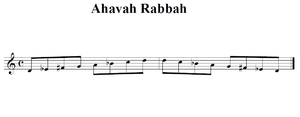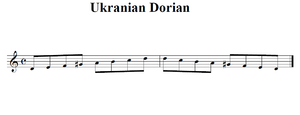Jewish prayer modes
Jewish liturgical music is characterized by a set of musical modes.
The prayer modes form part of what is known as the musical nusach (tradition) of a community, and serve both to identify different types of prayer and to link those prayers to the time of year or even time of day in which they are set. Various Jewish traditions developed their own modal systems, such as the maqamat of the Middle Eastern Jewish communities. The modes discussed in this article are specific to the traditions of Eastern European (Ashkenazi) Jewish Communities.
There are three main modes, as well as a number of combined or compound modes. The three main modes are called Ahavah Rabbah, Magein Avot and Adonai Malach. Traditionally, the Cantor (Hazzan) improvised sung prayers within the designated mode, while following a general structure of how each prayer should sound. Over time many of these chants have been written down and standardized, yet the practice of improvisation still exists to this day. Early studies in the history of Jewish Prayer Modes concluded that the musical scales used were based upon ancient Biblical cantillation,[1] but modern scholarship has questioned the validity of these findings.
Ahavah Rabbah Mode

The Ahavah Rabbah mode - sometimes referred to as Freygish (Phrygian dominant) - is named after the blessing that immediately precedes the Sh’ma in the morning service. This blessing begins with the words Ahavah Rabbah (literally: great love), and describes how God’s love for Israel is manifest through God’s revelation of Torah. Musically, Ahavah Rabbah is considered to be the most Jewish sounding of all the prayer modes, because of the interval of a flattened second, creating a minor third interval between the second and third scale degrees.[2] This mode is used in the beginning of the weekday evening service through the Chatzi Kaddish, a large portion of the weekday morning service, parts of the Shabbat morning service, and occasionally on the High Holidays. The Ahavah Rabbah mode is also used in many Jewish folk songs, such as Hava Nagila, and popular liturgical melodies, such as Yismechu. It is similar to the Arabic maqam Hijaz, but whereas the dominant of Hijaz is on the fourth degree, Ahavah Rabbah strongly favors the third.
Ukrainian Dorian Mode

The Ukrainian Dorian mode is a combined scale built upon the seventh degree of the Ahavah Rabbah scale. It is also closely related to the Magein Avot mode, in that a pre-concluding phrase in Ukrainian Dorian can cadence on its supertonic which is the 5th degree of the relative Magein Avot scale. This happens quite often in the nusach for the Three Festivals.[3] It is similar to the Arabic maqam Nikriz.
Magein Avot Mode

The Magein Avot (literally: Shield of our Fathers) mode takes its name from a paragraph in the Me'ein Sheva prayer, which directly follows the Amidah in the Friday evening service. Musically, it most closely resembles a minor scale from the Western classical music tradition or the Arabic maqam Nahawand . It is used in simple davening, or prayer chant, often by means of a single recitation tone, which the Cantor (Hazzan) uses to cover a large amount of liturgical text in a quickly-flowing style. The simplicity of both the mode and the chanting associated with it is meant to reflect the peaceful atmosphere of Shabbat. When chanting in the Magein Avot mode, it is common for the Cantor (Hazzan) to pivot into the relative major at certain liturgical points, often to highlight a particular line of text. It is this use of the relative major, in concert with Magein Avot, that distinguishes the mode from a regular minor scale. In addition to Shabbat evening, the Magein Avot mode is also prominent for the opening blessings of the weekday morning and afternoon services.[4]
Yishtabach Mode
The Yishtabach mode is a variant of the Magein Avot scale that flats the second scale degree.
Adonai (HaShem) Malach Mode

The Adonai Malach (literally: God Reigns) mode consists of a major scale with a lowered (minor) seventh and tenth. This mode has a majestic feel to it and is used for a number of services that require a grand atmosphere. Traditionally, it is used for psalms 95-99 in Kabbalat Shabbat, Lekhah Dodi in Kabbalat Shabbat, and the Friday night Kiddush. On Shabbat morning it is used for the Avot and G'vurot, during the Torah service, and on Rosh Chodesh when blessing the new month. Adonai Malach mode is also used at various times during the High Holidays when a majestic quality is required, such as the Shofar service, and parts of the Amidah.[5]
Maneuvers
Maneuvers are used within prayer chants in order to change the mood and mode during prayer. There are a few characteristic moves that Cantors tend to use in order to modulate through various modes. Two of the most common maneuvers are the Yishtabach maneuver and the Sim Shalom maneuver.
Yishtabach Maneuver
The Yishtabach maneuver moves from Magein Avot to Adonai Malach on the 4th degree of the scale. It then moves through Ukrainian Dorian and back to Magein Avot. This maneuver helps to highlight the grandeur of the proclamation of God's name that occurs in the final blessing of the Shabbat morning service.[6]
Sim Shalom Maneuver
The Sim Shalom maneuver, which is named after the prayer in which it often occurs, begins in Ahavah Rabbah, and modulates to the major key on the 4th degree of the scale. It also uses Ukrainian Dorian as a shift back to the original Ahavah Rabbah.[7]
References
Works Cited
| Wikimedia Commons has media related to Jewish Prayer Modes. |
- Cohon, Baruch Joseph. "The Structure of Synagogue Prayer Chant." Journal of the American Musicological Society 3, no. 1, 17-32, 1950.
Further reading
- Idelsohn, A.Z. Jewish Music: Its Historical Development. New York: Henry Holt and Co., 1929. Reprint New York: Dover Publication, 1992.
- Charles Davidson, Immunim Benusaḥ Hatefillah (3 vols): Ashbourne Publishing 1996
- Sholom Kalib, The Musical Tradition of the Eastern European Synagogue (2 vols out of projected 5): Syracuse University Press 2001 (vol 1) and 2004 (vol 2)